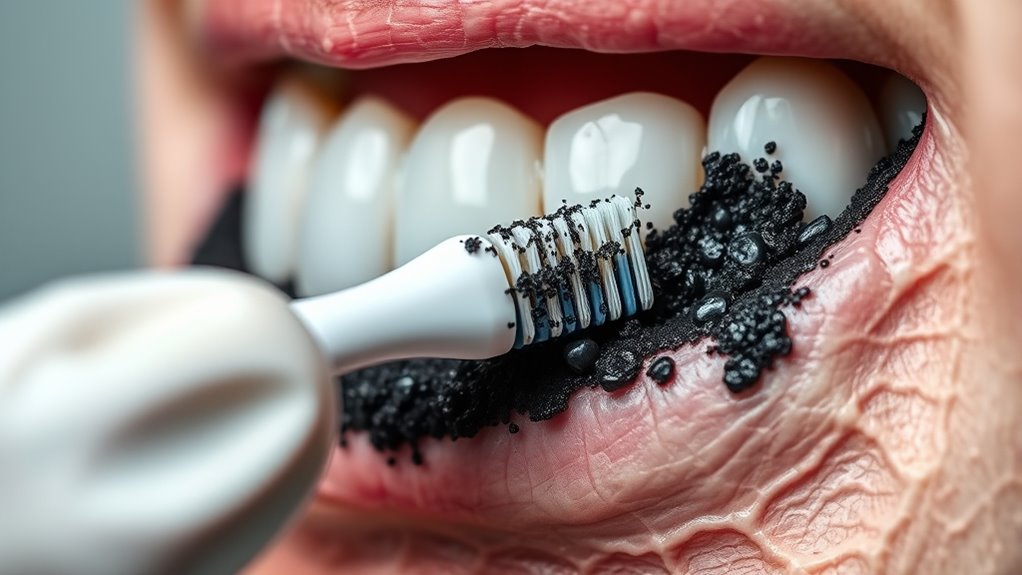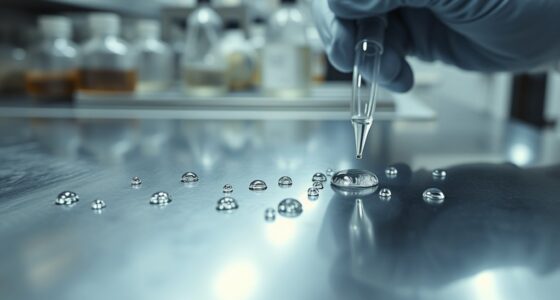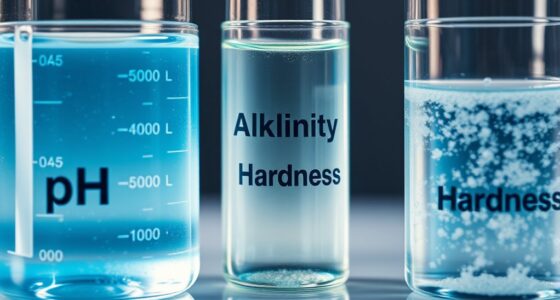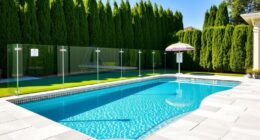Many believe that chemical treatments alone can quickly remove black algae, but that’s a myth. Proper brushing technique is essential because it physically disrupts algae colonies, breaking their protective layers and loosening stubborn spots. Relying solely on chemicals often allows algae to hide or resist removal. By mastering a focused, consistent brushing approach, you’ll see better long-term results. If you’re curious about effective methods, there’s more to learn about combining techniques for lasting cleanliness.
Key Takeaways
- Superficial cleaning and harsh chemicals often fail because black algae cling tightly to surfaces and resist simple removal.
- Proper brushing techniques, including targeted strokes at a 45-degree angle, effectively break through algae colonies.
- Physical disruption through scrubbing exposes algae to treatments, preventing quick regeneration.
- Consistent, gentle brushing over two minutes ensures thorough removal without damaging surfaces or tissues.
- Combining proper brushing with routine maintenance and chemical treatments offers the best long-term algae control.
Common Misconceptions About Black Algae Removal

Many people believe that black algae can be easily removed with simple scrubbing or harsh chemicals, but this isn’t always the case. While scrubbing might seem effective initially, black algae often cling tightly to surfaces, making them resistant to superficial cleaning. Harsh chemicals can sometimes damage pool surfaces or cause health hazards without fully eliminating the algae. Some think that using chlorine alone will solve the problem, but algae can develop resistance or hide in hard-to-reach spots. Overusing chemicals or aggressive scrubbing can also lead to increased algae growth if not combined with proper maintenance. It’s a misconception that black algae is impossible to control; with the right approach, you can effectively eliminate it, but understanding its resilience is key. Additionally, recent AI discoveries have shown that targeted approaches and innovative techniques can improve algae removal strategies significantly.
The Role of Brushing Technique in Eliminating Black Algae

Your brushing technique can make all the difference in removing black algae effectively. Focus on maintaining the proper brushing angle to target stubborn spots and guarantee you’re consistent with your schedule. Don’t forget to prioritize affected areas to prevent algae from spreading and returning. Additionally, understanding the pinball machine weight can help when managing cleaning tools and equipment around the area.
Proper Brushing Angle
Achieving the right brushing angle is essential for effectively removing black algae from pool surfaces. You want to angle your brush so that the bristles make direct contact with the algae’s growth area, allowing maximum scrubbing power. A proper angle helps dislodge stubborn patches without damaging the surface. Typically, hold your brush at about a 45-degree angle to the pool wall or floor. Understanding industry trends aids in selecting the best techniques for efficient cleaning.
Consistent Brushing Schedule
Maintaining a consistent brushing schedule is key to preventing black algae from taking hold and spreading. Regular brushing disrupts algae growth before it becomes entrenched, making it easier to manage. By sticking to a routine, you guarantee that all surfaces are cleaned frequently, reducing the chance for algae to establish a foothold. Consistency also helps you identify problem areas early, allowing for targeted action. Skipping brushing sessions gives algae time to grow and spread, complicating removal efforts. Establishing and maintaining a schedule keeps algae at bay and supports clearer, healthier water. Additionally, understanding the importance of projector contrast ratio can help in creating optimal viewing conditions for your home cinema.
Targeting Affected Areas
Have you ever wondered why some algae stubbornly persist despite regular cleaning? It’s often because you’re not targeting the right spots. Black algae tend to cling to specific areas like tile grout, corners, or rough surfaces where debris and moisture accumulate. To eliminate them effectively, focus your brushing on these affected areas with firm, direct strokes. Use a stiff-bristled brush to scrub thoroughly, breaking through algae colonies. Don’t forget to apply a specialized algae remover beforehand to loosen stubborn patches. By honing your technique on the problem spots, you prevent algae from spreading and ensure a cleaner, healthier pool. Targeted brushing is essential because surface penetration and cleaning deep into cracks and crevices is necessary for complete removal.
Why Chemical Treatments Alone Often Fail
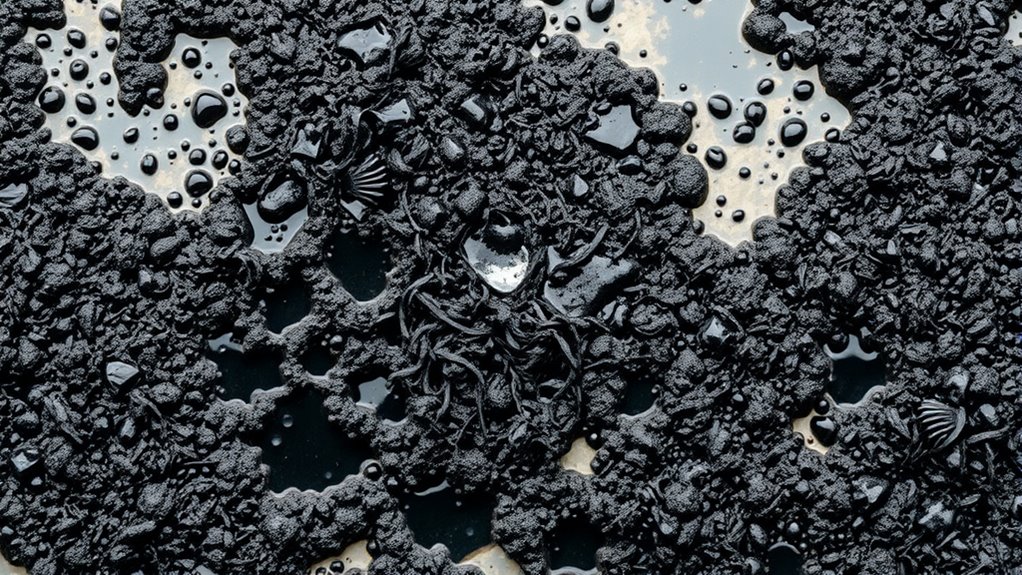
Chemical treatments alone often fall short because algae can quickly develop resistance or adapt to these chemicals, rendering them less effective over time. When you rely solely on chemicals, algae can form protective barriers or change biochemistry, making future treatments less impactful. This adaptation process can significantly reduce the long-term efficacy of chemical solutions. Additionally, environmental factors like sunlight and water flow can dilute or deactivate chemicals, reducing their potency. Overuse of chemicals can also harm beneficial aquatic life and lead to chemical buildup. To truly control algae, chemical treatments need to be part of a broader strategy that includes physical removal and proper maintenance. Understanding the role of Gold IRA fees and other costs can help manage overall resources when implementing comprehensive algae control strategies.
The Importance of Physical Disruption for Effective Cleaning
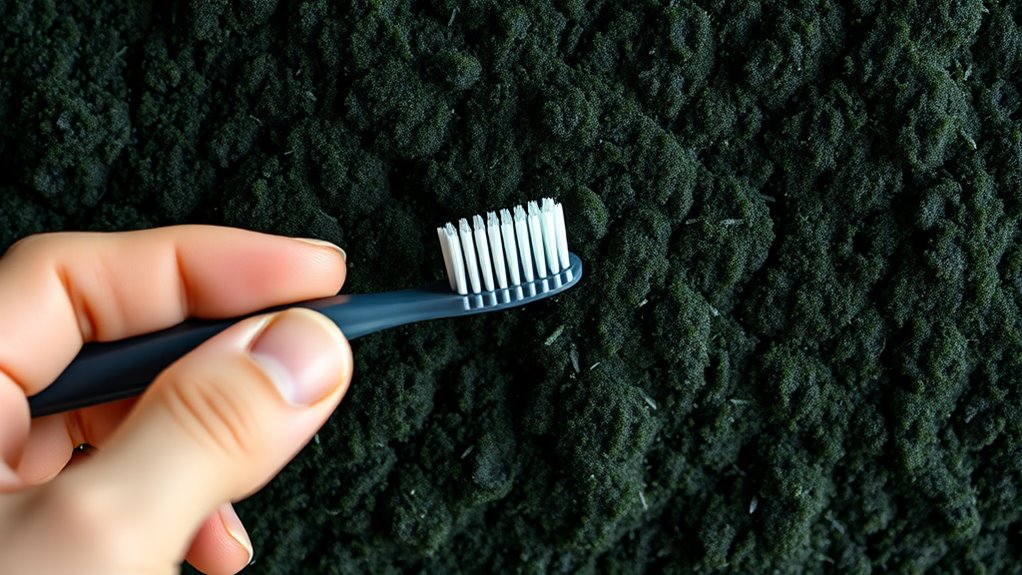
Physical disruption plays a crucial role in effectively controlling algae because it directly removes the algae’s protective layers and disrupts their growth structures. When you scrub or brush the affected surfaces, you break apart the algae’s slimy coating, exposing it to harsh conditions and making it more vulnerable to treatments. This process prevents the algae from anchoring itself deeply or spreading further. Without physical disruption, algae can quickly regenerate, even after chemical treatments. By physically disrupting the algae, you weaken its structure and reduce its resilience, speeding up overall cleaning efforts. Additionally, integrating automation’s role in business intelligence can help monitor and optimize cleaning schedules for better results. Remember, the key isn’t just applying chemicals—it’s combining them with effective scrubbing to ensure maximum removal and long-lasting results. This proactive approach is essential for keeping algae at bay.
Demonstrating Proper Brushing Methods for Best Results
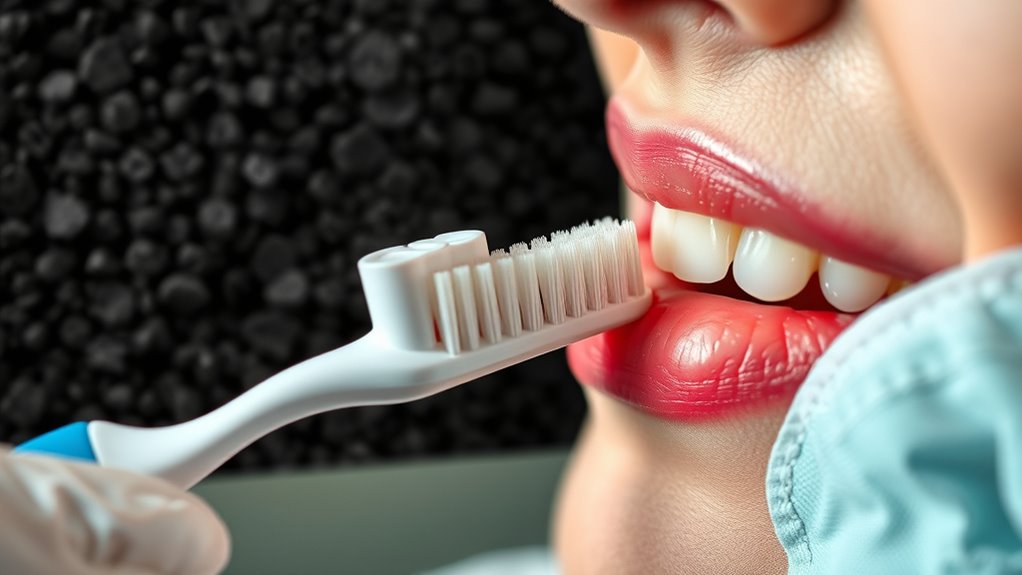
To get the best results, you need to brush correctly. Start by choosing the right brush and use gentle circular motions to clean effectively. Keep your brushing consistent and avoid rushing through the process. Incorporating protective styling benefits can help maintain the health of your hair during this routine.
Choose the Right Brush
Choosing the right brush is essential for effective algae removal and maintaining healthy teeth. The correct brush helps you clean thoroughly without damaging your gums or enamel. Look for a brush with soft bristles; they’re gentle yet effective at removing plaque and algae. Consider the size of the brush head—smaller heads can reach tricky areas more easily. An ergonomic handle can improve your grip and control during brushing. Electric brushes with timers or pressure sensors can enhance your technique and ensure you don’t overdo it. Selecting the right brush is about comfort and efficiency, ensuring you can clean thoroughly without causing harm. Kia Tuning techniques can also be customized to improve your vehicle’s performance and handling.
Use Gentle Circular Motions
Using gentle circular motions while brushing helps guarantee you remove plaque and algae effectively without harming your gums or enamel. Instead of scrubbing aggressively, focus on small, slow circles that cover each tooth’s surface. This technique ensures thorough cleaning without causing irritation or damage. Maintain a light touch—pressing too hard can wear down enamel and irritate gums. Circular motions help loosen debris and algae from crevices and along the gum line, reaching areas that straight-back brushing might miss. Be consistent with your movements, moving from one section of your mouth to the next. Remember, the goal is to clean effectively while protecting your oral tissues. Proper technique like this makes a significant difference in maintaining healthy teeth and gums over time. Recognizing the importance of trust and communication in relationships underscores the value of gentle, effective actions—whether in brushing or building trust with others.
Maintain Proper Brushing Duration
Maintaining the right brushing duration is essential for effective cleaning without causing damage. Brushing too briefly can leave plaque and algae behind, while brushing too long may irritate gums or wear down enamel. Aim for about two minutes, ensuring you cover all areas evenly. Use a timer or play a short song to keep track. Focus on gentle, consistent strokes rather than rushing. Regularly check your technique to avoid overbrushing, which can harm your mouth. Proper timing enhances plaque removal and algae control, leading to healthier teeth and gums. Remember, quality matters more than speed. Be mindful of your brushing duration to maximize results and protect your oral health.
- Use a timer or song for accurate duration
- Focus on gentle, consistent strokes
- Cover all areas evenly
- Avoid overbrushing to prevent damage
Combining Brushing With Maintenance for Long-Term Prevention

While brushing alone is essential, combining it with regular maintenance routines markedly boosts your long-term algae prevention efforts. Consistently cleaning your pool filters, skimming debris, and monitoring chemical levels work hand-in-hand with brushing to keep algae at bay. Regularly checking and maintaining proper pH and chlorine levels creates an environment hostile to algae growth. Using algaecides periodically can also reinforce your defenses, especially during peak algae seasons. Establishing a routine schedule ensures you don’t overlook key tasks that contribute to a clean, algae-free pool. When you integrate brushing with these maintenance practices, you reduce the chances of algae slipping through gaps, saving you time and effort in the long run. This holistic approach keeps your pool clearer and healthier for longer.
Frequently Asked Questions
Can Black Algae Return After Proper Cleaning?
Yes, black algae can return even after proper cleaning. To prevent this, you need to maintain regular brushing, guarantee your pool’s chemical levels are balanced, and filter it properly. Consistent upkeep is key because algae spores can linger and re-establish if conditions become favorable. Keeping your pool clean and chemically balanced helps minimize algae growth, but ongoing maintenance is essential for long-term prevention.
How Often Should I Brush to Prevent Black Algae?
You should brush your pool at least twice a week to prevent black algae. Imagine the gentle ripple of water, each stroke disrupting algae spores before they settle and grow. Regular brushing keeps surfaces clean and discourages algae from taking hold. If you notice stubborn spots, increase your frequency temporarily. Consistent maintenance is key, so make brushing a routine part of your pool care, and black algae won’t stand a chance.
Are There Eco-Friendly Alternatives to Chemical Treatments?
Yes, there are eco-friendly alternatives to chemical treatments. You can use natural options like baking soda, vinegar, or hydrogen peroxide, which are effective at combating black algae without harming the environment. Regular brushing helps improve results, but combining these with eco-friendly solutions makes your pool safer and greener. You might also consider installing UV or ozone systems, which reduce algae growth without relying on harsh chemicals.
Does Water Temperature Affect Black Algae Growth?
Yes, water temperature does affect black algae growth. Warmer water creates an ideal environment for algae to thrive, as it speeds up their metabolism and reproduction rates. If you keep your pool water cooler, you can slow down algae development. Regularly monitor and maintain *best* temperature levels, especially during hot months, to prevent black algae from taking hold. Proper circulation and sanitation also help control growth regardless of temperature.
What Tools Are Best for Effective Black Algae Removal?
You should grab a stiff-bristled brush or algae scrubber, a good quality hose, and a pool brush for best results. These tools help you tackle stubborn black algae effectively. Don’t put all your eggs in one basket—combine scrubbing with a powerful pool cleaner or algaecide for thorough removal. Remember, a little elbow grease and the right tools go a long way in winning the battle against black algae.
Conclusion
Remember, mastering your brushing technique is key to banishing black algae effectively. Did you know that improper brushing can leave up to 70% of algae behind? By physically disrupting the algae’s growth, you boost your chances of a crystal-clear pool. Don’t rely solely on chemicals—combine proper brushing with regular maintenance for lasting results. Stay consistent, and you’ll enjoy a healthier, algae-free pool all season long.
